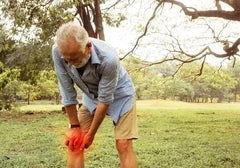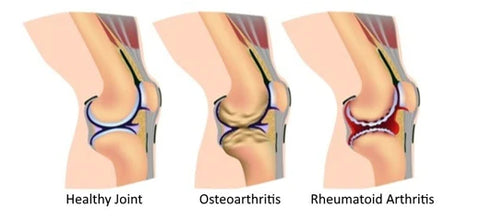Rheumatoid Arthritis vs Osteoarthritis
That’s it. That joint pain is too much. You feel weak, tender, pain-inflicted, always tired, and depressed. Your joints hurt. It’s time to schedule a doctor’s appointment. So, is it Osteoarthritis or Rheumatoid Arthritis?
There is a single factor that both conditions share: that is inflammation. This is also true with any autoimmune condition out there.
So, you are probably thinking - what does CBD have to do with all that. Well, CBD/hemp oil (full spectrum/broad spectrum) is very powerful in mitigating inflammation. You can read our founder’s blog-story describing exactly how powerful hemp oil is for pain.

Is it Osteoarthritis or Rheumatoid Arthritis?
You’ve probably heard of the two most common forms of arthritis – Osteoarthritis and Rheumatoid Arthritis. Both, seemingly, have the same effect – joint pain.
But these two conditions are worlds apart. One is systemic and the other is local.
So how will your doctor diagnose and distinguish whether it’s Rheumatoid Arthritis or Osteoarthritis. And, regardless, why does CBD have the power to help? In one word – inflammation.
The following read can help you, an individual with joint pain, make an educated decision on whether you have Osteoarthritis or Rheumatoid Arthritis. Statistically, by the way, you are most likely to have Osteoarthritis, since only 2% of the population suffer from Rheumatoid Arthritis, whereas as much as 25% of the population suffers from some form of Osteoarthritis.
What are the root causes for Osteoarthritis and for Rheumatoid Arthritis?
Let’s first look at the root cause of the pain:
In Rheumatoid Arthritis, the pain is a result of an autoimmune reaction – the body’s immune system is attacking the joints. It’s a whole-body kind of process. And once the immune system goes for an attack, this means inflammation.
In Osteoarthritis, on the other hand, we are dealing with wear and tear or, in other words, overuse. Overuse means that a joint (usually a weight-bearing joint) has been under a lot of strain, whether it’s simply ‘wear and tear’ that comes with old age, or whether it’s the result of high pressure on central joints resulting from one being overweight. It can also be a result of extensive joint use that comes with practicing various types of sports.
And, again, the common denominator between the two conditions is inflammation. And while there are numerous medications out there to fight inflammation, there is an all-natural alternative, or, at least, a supporting supplemental treatment. As you guessed, I am referring to CBD, or rather, hemp oil that has very strong anti-inflammatory qualities. Read more about how CBD for pain treatment works.
What are the commonalities between Osteoarthritis and Rheumatoid Arthritis?
Let’s discuss the commonalities between these two conditions. This discussion is extremely important since, at the bottom line, people will go to a doctor and complain about the same thing – their joints hurt.
Both Osteoarthritis, as well as Rheumatoid Arthritis, can be extremely painful and involve stiffness. So, what do we naturally do when a joint is painful? Right, avoid using it. By doing so, we promote muscular weakness, loss of function, and the inability to do things we like to do.
Indirectly, these limitations effect our mood, and many patients will also report depression along with pain. Heart disease is also common as well as other risks that result from a sedentary lifestyle.

What are the differences between Osteoarthritis and Rheumatoid Arthritis?
1. Symmetry or asymmetry?
A critical question to ask is – where does it hurt? Which joints? The answer holds a lot of information since here there are very distinctive characteristics that distinguish Osteoarthritis and Rheumatoid Arthritis, and, to put it simple it’s a matter of symmetry or lack of symmetry.
You see, Rheumatoid Arthritis begins and progresses symmetrically across both sides of the body. This means that with RA, if your right-hand wrist joint hursts, so will the left wrist. Same for fingers, elbows, shoulders, etc. Note the plural form in all the mentioned joints – fingers, elbows, shoulders, knees, shoulders, etc.
So, patients will come and say that their shoulders hurt, and not only a shoulder, or, that their knees hurt, not only one knee.
In Osteoarthritis, on the other hand, we see asymmetry. This is because Osteoarthritis, as mentioned, comes from excessive joint use, and this kind of use is probably not going to be even between the left and right side of the body. Additionally, the joint cartilage that we start with might not be the same in both sides.
So, an Osteoarthritis patient can report on random joints hurting, like - one shoulder, the opposite knee, same-side ankle, and the opposite-side wrist. The pattern of Osteoarthritis is sporadic.
2. Which joints are affected?
Another important clue is the specific joints that are affected by the condition. For instance, in our hands, we have various finger knuckles, with the very last knuckle in each of our fingers, the closest to the tip of the fingers, called DIP (distal interphalangeal joints). If we keep going towards the wrist, the next set of knuckles is going to be called PIP (proximal interphalangeal joints). The logic is proximal or closer to the center of the body.
So, in Rheumatoid Arthritis, surprisingly, the DIP joints are spared, meaning, these DIP joints are usually not affected. So, Rheumatoid Arthritis will most likely affect the proximal joints.
As you probably guessed, with Osteoarthritis, the DIP is not spared, so the very last joints can be affected. But again, it’s not symmetrical, so one might have a finger or two hurt in one hand, but not in the other

3. Does It Hurt Most in The Morning or In the Evening?
Since autoimmune diseases, as mentioned, are not caused by overuse of the joints. So, with patients with Rheumatoid Arthritis, their symptoms will be the worst in the morning. When waking up, joints are painful and stiff. This painful stage has a name – morning stiffness.
Morning stiffness is very individual and can last anywhere between a few minutes, to a few hours. If you haven’t experienced it, you’ll never understand. You really feel like a pain-inflicted, useless rag. But, as the day progresses, and you get up more and move around, the stiffness gets better, so, in fact, as you use the joints more, the better they get, and symptoms are lessened.
Since we know that Osteoarthritis comes from overuse, yes, as you guessed, the pain and stiffness are going to be exactly the other way around vs. Rheumatoid Arthritis – when an Osteoarthritis patient wakes up after a restful night, joints have rested too, so pain and stiffness is a lot better. But, as joints are being used, it gets worse.
How to tell if it is Osteoarthritis or Rheumatoid Arthritis by a physical exam of the joints?
In Rheumatoid Arthritis, the inflamed joints are going to feel warm and soft, and will appear red.
In Osteoarthritis, we are going to have some enlargements. Maybe the shape of the fingers has changed but usually, these joints are not warm to touch.
Joint shape
Rheumatoid Arthritis definitely affects the shape of the joints, sometimes dramatically. So, with Rheumatoid Arthritis, the joints will be somewhat more twisted. Under this condition, joints that are affected might develop cysts, which are fluid-filled sacs, all as the body’s reaction to inflammation.
On the other hand, in Osteoarthritis, an affected joint will display more of an enlargement.
Furthermore`, with Osteoarthritis, if the patient is using his joint, you might actually be able to hear something. These goose-bump-causing noises are called crepitus, which is the sound that a joint will make when there’s bone grinding on bone. A sound of friction and grinding. Ouch!
The time of onset of the condition
We should be born with plenty of cartilage, and this cartilage wears over time. So, the onset of Osteoarthritis should be slow. It should take years to develop (unless we are talking about sportsmen who excessively use their joints) and its severity should look like a steady upgoing curve.
Then, for Rheumatoid Arthritis, the disease effect is random, or rather cyclical with waves of flare-ups and periods of low disease activity. In other words, the disease activity curve is wavey. Every such flare-up leaves tiny damages in affected joints. If not treated properly, this damage accumulates and leads to irreversible joint deformation.

Other Symptoms of Rheumatoid Arthritis and Osteoarthritis
With Rheumatoid Arthritis, as flares go up and down, this systemic disease can affect other body parts and organs and can cause, for example, fever, vasculitis (inflammation of the blood vessels), lung and heart problems, and a feeling of total body illness.
With Osteoarthritis, there shouldn’t be any systemic consequences, but rather local. However, as with every other mobility limiting condition, a person is not free to do anything on their mind and can’t be himself and this feeling and change in life, may lead to depression.
Is CBD oil good for Osteoarthritis and for Rheumatoid Arthritis?
As I discussed in previous blog posts, CBD, and the other cannabinoids in hemp oil work together and have a strong effect in fighting inflammation and joint pain. This effect is known as the entourage effect.
As discussed, the common factor between Osteoarthritis and Rheumatoid Arthritis is that inflammation is involved:
- In Rheumatoid Arthritis, it’s the immune system that attacks the joints and triggers inflammation
- In Osteoarthritis, immune activation is seen in the affected joints following the cartilage damage. As Osteoarthritis progresses, inflammation can happen around the affected joint, but such inflammation is not limited to advance stages of Osteoarthritis.
Researches have shown that MRIs taken in early stages of Osteoarthritis, sometimes indicate inflammation, even though, the joint cartilage seems undamaged.
In the bottom line, in both conditions, it’s critical to get the proper treatment as early as possible since it’s joint damage that occurs cannot be reversed and, in some cases, joint replacement becomes inevitable.
Supplemental natural products like Reclaim Lab’s oils and roll-ons can offer great joint support and help in fighting inflammation. Our THC-Free CBD-rich hemp oil and our Broad Spectrum CBD-rich hemp oil serve as a systemic support in fighting inflammation, whereas our Full Spectrum Relief Roll-On Stick is great with fighting local joint pain.
